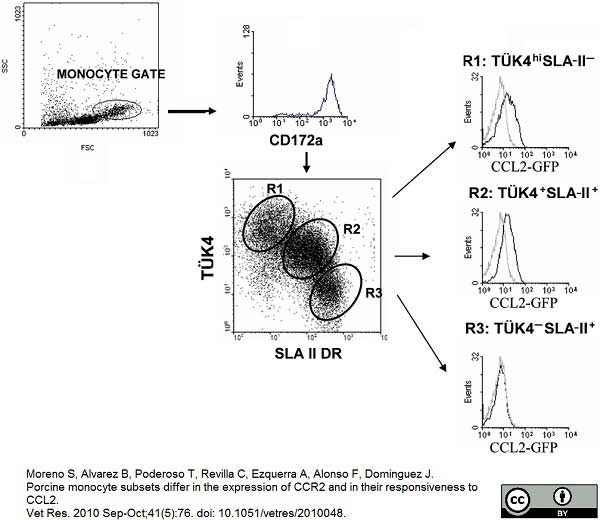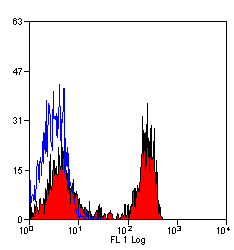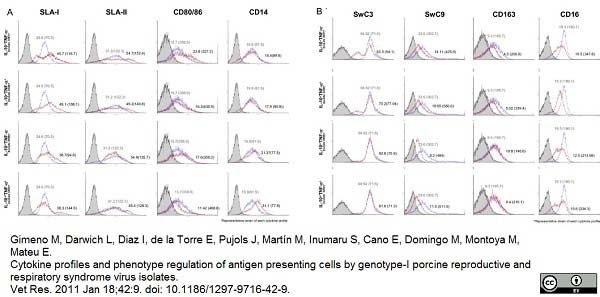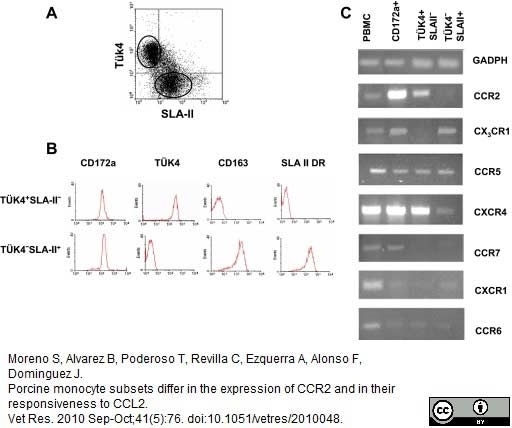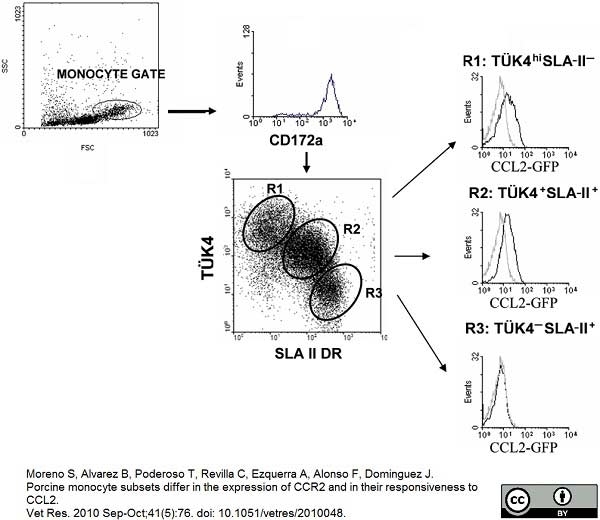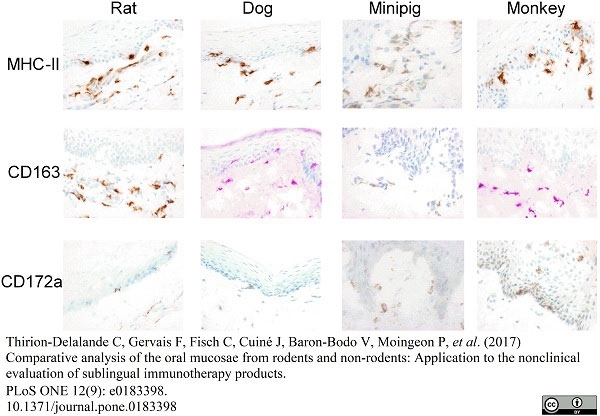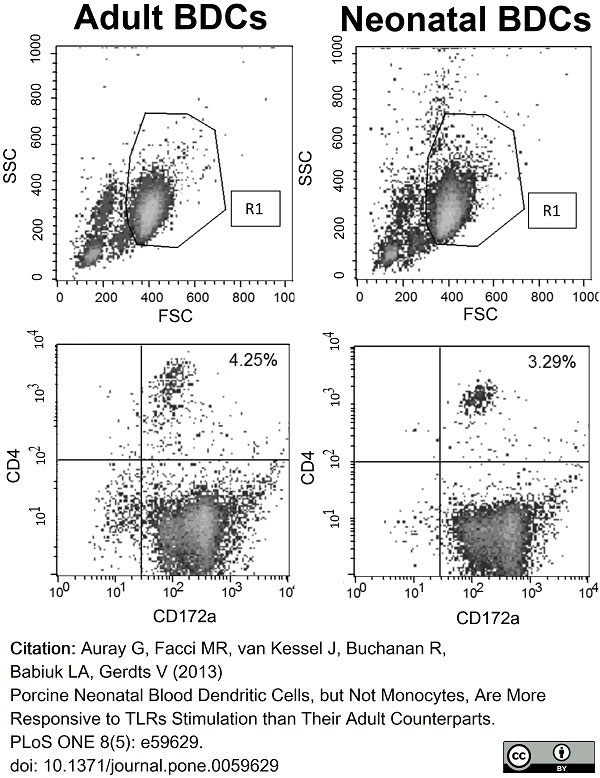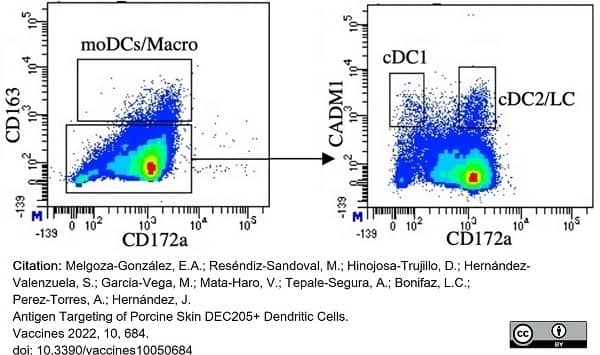CD172a antibody | BL1H7








Mouse anti Pig CD172a:FITC
- Product Type
- Monoclonal Antibody
- Clone
- BL1H7
- Isotype
- IgG1
- Specificity
- CD172a
| Mouse anti Pig CD172a, clone BL1H7 recognizes porcine CD172a, a member of the signal regulatory protein (SIRP) family (Alvarez et al. 2000). Mouse anti Pig CD172a, clone BL1H7 was originally clustered as SWC3 at the Third International Swine Cluster of Differentiation Workshop (Haverson et al. 2001;Thacker et al. 2001). CD172a is expressed on monocyte derived dendritic cells (MoDCs) (Facci et al. 2010) also conventional (cDCs), plasmacytoid (pDCs) DCs and blood DCs.(Facci; Jeong et al. 2010). Mouse anti Pig CD172a, clone BL1H7 immunoprecipitates a single band of ~90-110 kDa from preparations of biotinylated alveolar macrophages, a result confirmed by Western blotting analysis of alveolar macrophage lysates under non reducing conditions (Alvarez et al. 2000). Aberrant expression of CD172a has been noted on porcine leukemias (Sipos et al. 2006) with blast cells co-expressing lymphocytic markers CD5 and CD25 whilst expressing the Myeloid marker CD172a in a bi-phenotypic pattern as opposed to the more characteristic single population of CD172+ cells seen in normal blood PBMC (Chamorro et al. 2005). Mouse anti Pig CD172a, clone BL1H7 has proved a useful and reliable tool for immunohistochemical analysis of routinely processed, formalin fixed, paraffin embedded porcine tissues (Domenech et al. 2003). |
- Target Species
- Pig
- Product Form
- Purified IgG conjugated to Fluorescein Isothiocyanate Isomer 1 (FITC) - liquid
- Preparation
- Purified IgG prepared by affinity chromatography on Protein A from tissue culture supernatant
- Buffer Solution
- Phosphate buffered saline
- Preservative Stabilisers
- 0.09% sodium azide (NaN3)
1% bovine serum albumin - Immunogen
- Porcine alveolar macrophages.
- Approx. Protein Concentrations
- IgG concentration 0.1 mg/ml
- Fusion Partners
- Spleen cells from immunised BALB/c mice were fused with cells of the mouse SP2/0 myeloma cell line.
- Max Ex/Em
-
Fluorophore Excitation Max (nm) Emission Max (nm) FITC 490 525 - Regulatory
- For research purposes only
- Guarantee
- 12 months from date of despatch
Avoid repeated freezing and thawing as this may denature the antibody. Storage in frost-free freezers is not recommended. This product is photosensitive and should be protected from light.
| Application Name | Verified | Min Dilution | Max Dilution |
|---|---|---|---|
| Flow Cytometry | Neat | 1/10 |
- Flow Cytometry
- Use 10μl of the suggested working dilution to 1x106 cells in 100μl
| Description | Product Code | Applications | Pack Size | List Price | Your Price | Quantity | |
|---|---|---|---|---|---|---|---|
| Mouse IgG1 Negative Control:FITC | MCA928F | F | 100 Tests |
|
Log in | ||
| List Price | Your Price | ||||||
|
|
Log in | ||||||
| Description | Mouse IgG1 Negative Control:FITC | ||||||
References for CD172a antibody
-
Alvarez, B. et al. (2000) A porcine cell surface receptor identified by monoclonal antibodies to SWC3 is a member of the signal regulatory protein family and associates with protein-tyrosine phosphatase SHP-1.
Tissue Antigens. 55 (4): 342-51. -
Domenech, N. et al. (2003) Identification of porcine macrophages with monoclonal antibodies in formalin-fixed, paraffin-embedded tissues.
Vet Immunol Immunopathol. 94 (1-2): 77-81. -
Carrillo, A. et al. (2002) Isolation and characterization of immortalized porcine aortic endothelial cell lines.
Vet Immunol Immunopathol. 89 (1-2): 91-8. -
Fraile, L. et al. (2012) Immunomodulatory properties of beta-sitosterol in pig immune responses.
Int Immunopharmacol. 13 (3): 316-21. -
Jeong, H.J. et al. (2010) Comparative measurement of cell-mediated immune responses of swine to the M and N proteins of porcine reproductive and respiratory syndrome virus.
Clin Vaccine Immunol. 17 (4): 503-12. -
Gimeno, M. et al. (2011) Cytokine profiles and phenotype regulation of antigen presenting cells by genotype-I porcine reproductive and respiratory syndrome virus isolates.
Vet Res. 42: 9. -
Moreno, S. et al. (2010) Porcine monocyte subsets differ in the expression of CCR2 and in their responsiveness to CCL2.
Vet Res. 41: 76. -
Facci, M.R. et al. (2010) A comparison between isolated blood dendritic cells and monocyte-derived dendritic cells in pigs.
Immunology. 129: 396-405.
View The Latest Product References
-
Clapperton, M. et al. (2005) Innate immune traits differ between Meishan and Large White pigs.
Vet Immunol Immunopathol. 104: 131-44. -
Argilaguet, J.M. et al. (2012) DNA vaccination partially protects against African swine fever virus lethal challenge in the absence of antibodies.
PLoS One. 7 (9): e40942. -
Kapetanovic, R. et al. (2012) Pig bone marrow-derived macrophages resemble human macrophages in their response to bacterial lipopolysaccharide.
J Immunol. 188: 3382-94. -
Tambuyzer, B.R. et al. (2012) Osteopontin alters the functional profile of porcine microglia in vitro.
Cell Biol Int. 36 (12): 1233-8. -
Robinson, S.R. et al. (2015) Broadly neutralizing antibodies against the rapidly evolving porcine reproductive and respiratory syndrome virus.
Virus Res. 203: 56-65. -
Li, J. & Murtaugh, M.P. (2015) Functional analysis of porcine reproductive and respiratory syndrome virus N-glycans in infection of permissive cells.
Virology. 477: 82-8. -
Prims. S. et al. (2016) Intestinal immune cell quantification and gram type classification of the adherent microbiota in conventionally and artificially reared, normal and low birth weight piglets.
J Livestock Sci 185: 1-7. -
Gardner, D.S. et al. (2016) Remote effects of acute kidney injury in a porcine model.
Am J Physiol Renal Physiol. 310 (4): F259-71. -
Valekova I et al. (2016) Revelation of the IFNα, IL-10, IL-8 and IL-1β as promising biomarkers reflecting immuno-pathological mechanisms in porcine Huntington's disease model.
J Neuroimmunol. 293: 71-81. -
Gardner, D.S. et al. (2016) Remote effects of acute kidney injury in a porcine model.
Am J Physiol Renal Physiol. 310 (4): F259-71. -
Thirion-Delalande, C. et al. (2017) Comparative analysis of the oral mucosae from rodents and non-rodents: Application to the nonclinical evaluation of sublingual immunotherapy products.
PLoS One. 12 (9): e0183398. -
Auray, G. et al. (2013) Porcine neonatal blood dendritic cells, but not monocytes, are more responsive to TLRs stimulation than their adult counterparts.
PLoS One. 8 (5): e59629. -
Hu, W. et al. (2021) shRNA transgenic swine display resistance to infection with the foot-and-mouth disease virus.
Sci Rep. 11 (1): 16377. -
Radlowski, E.C. et al. (2021) Combination-Feeding Causes Differences in Aspects of Systemic and Mucosal Immune Cell Phenotypes and Functions Compared to Exclusive Sow-Rearing or Formula-Feeding in Piglets.
Nutrients. 13(4):1097. -
Melgoza-González, A.E. et al. (2022) Antigen Targeting of Porcine Skin DEC205+ Dendritic Cells
Vaccines. 10 (5): 684. -
Zhou, L. et al. (2022) Clinical improvement of sepsis by extracorporeal centrifugal leukocyte apheresis in a porcine model.
J Transl Med. 20 (1): 538. -
Álvarez, B. et al. (2023) Porcine Macrophage Markers and Populations: An Update.
Cells. 12 (16): 2103.
Further Reading
-
Piriou-Guzylack, L. (2008) Membrane markers of the immune cells in swine: an update.
Vet Res. 39: 54.
- Synonyms
- SWC3
- RRID
- AB_2188073
- UniProt
- Q5K4Q3
MCA2312F
If you cannot find the batch/lot you are looking for please contact our technical support team for assistance.
Please Note: All Products are "FOR RESEARCH PURPOSES ONLY"
View all Anti-Pig ProductsAlways be the first to know.
When we launch new products and resources to help you achieve more in the lab.
Yes, sign me up